The inimitable Joanna Vandervlugt interviewed me about Beneath Malabar Nets
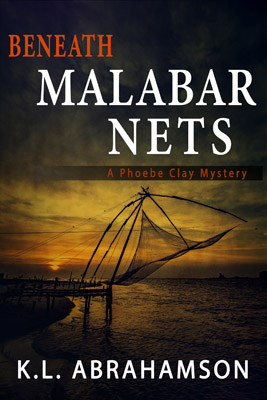
Check out the Podcast HERE.

Check out the Podcast HERE.

Sometimes… sometimes this world can be so darned hard to be in—like reading about the death of the last male northern white rhino, or that 18 of the Tigers ‘rescued’ from a Thai temple ended up dying. And then there’s the whole darn political situation where nobody seems to speak the whole truth.
But other times the world can be such a giving place that it overwhelms. That was my experience in Bhutan.
As I mentioned in a prior post, Bhutan is a Buddhist country. It isn’t a big country. It isn’t particularly modern in the way places like London, New York, or even Bangkok might be, but it’s a country that seems to understand the concept of ‘enough’. It might not be a wealthy country (up until this year it’s biggest source of revenue was tourism), but the government has decided not to rate the well-being of the country not on gross domestic product (in other words, how much does the country produce or earn each year), but instead they assess the country on Gross Domestic Happiness.
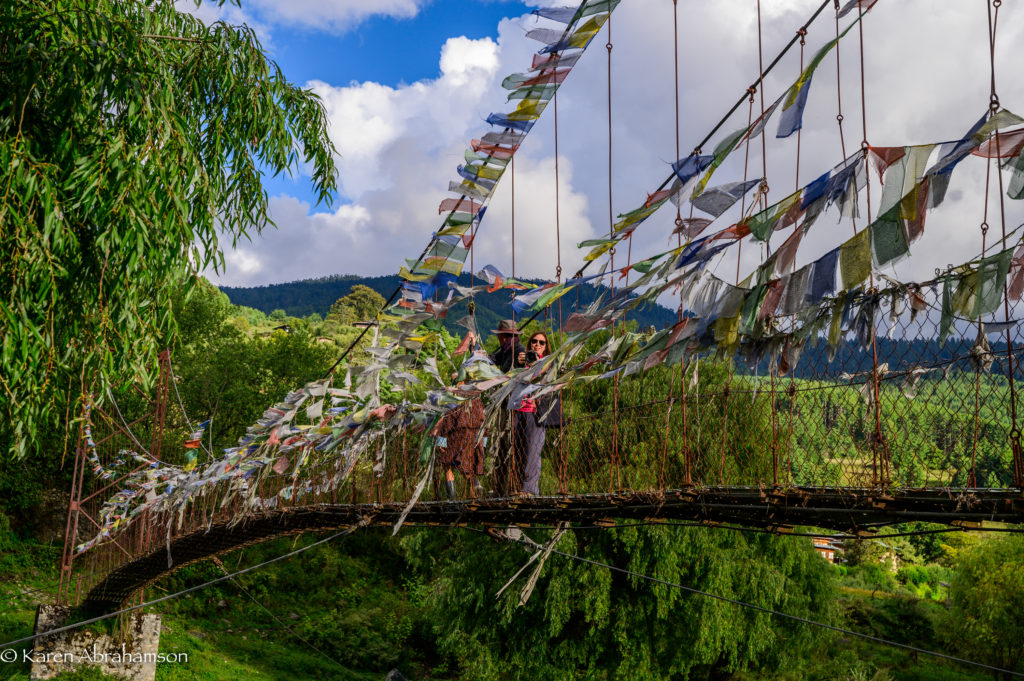
I’m not quite sure how they measure this apparently quite ‘ephemeral’ concept, but I have to say that the country seems to be doing quite well. Some of it seems to be the personal realizations of the citizens that they can have ‘enough’—maybe not from driving for the ‘high life’, but from something else. For instance, the country has put a lot of energy into education and has a well-educated middle class. This has lead to many young people leaving their traditional country villages for the city leading to pressure on Thimpu and Paro (the two main cities) and some concern for the farming tradition of the country. What did the country do? It offered sizeable subsidies for the well-educated young people to return to farming—and its working!
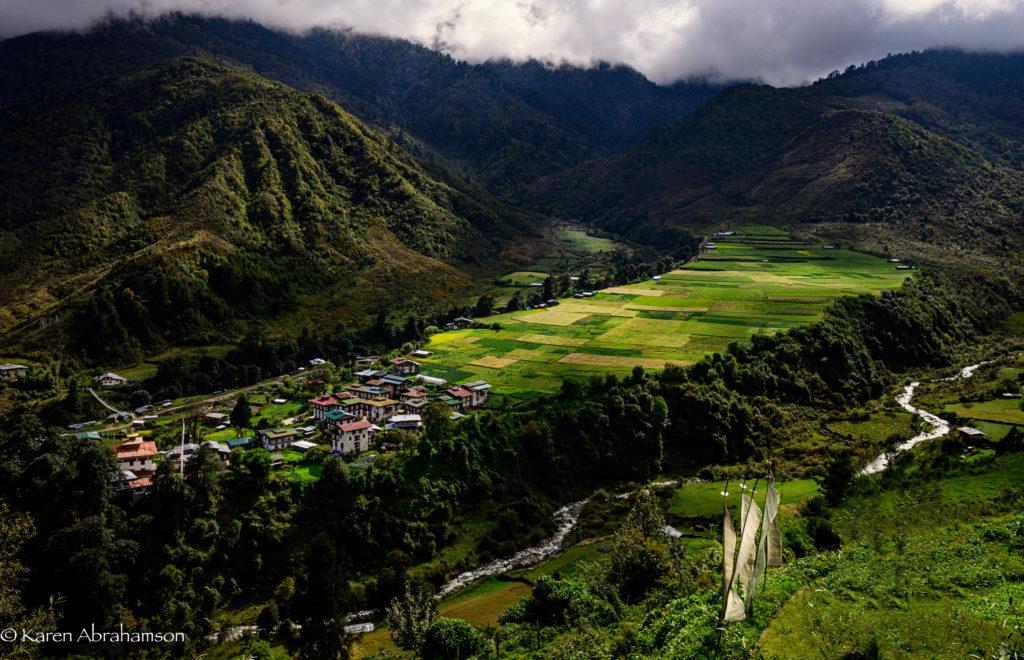
Bhutan is also a country that is trying hard to balance growth with protection of the environment. Compared to most countries around the world, Bhutan has actually seen an increase in the its national forest cover and it does things like set aside an entire fertile valley floor in order to preserve the habitat of the rare black-necked crane. Pretty progressive.
At the same time, tradition is everywhere. Come to a bridge, a river confluence, or mountain pass, and you find yourself amongst the fluttering host of red, yellow, green, blue or white prayer flags. Tradition says that with every gust of wind, the prayers connected to the flags are sent skyward to the benefit of the prayer flag’s patron. You become a patron by deciding to put up the flags but you’ll also see clusters of white prayer flags on poles that are raised in remembrance of the newly dead.
While I was in Thimpu, the capital, I had the chance to visit a Bhutanese astrologer who informed me that:
Given the astrologer was exactly right about the couple of bad years, I took the prayer flags he recommended and thought that I would hang some in Bhutan and some when I returned home. My kind and oh-so-knowledgeable guide, Kuenzang Norbu, researched dates that were bad to hang flags, and our wonderful driver, Tenzin Norbu (no relation) actually asked his father to research my best and worst days of the week.
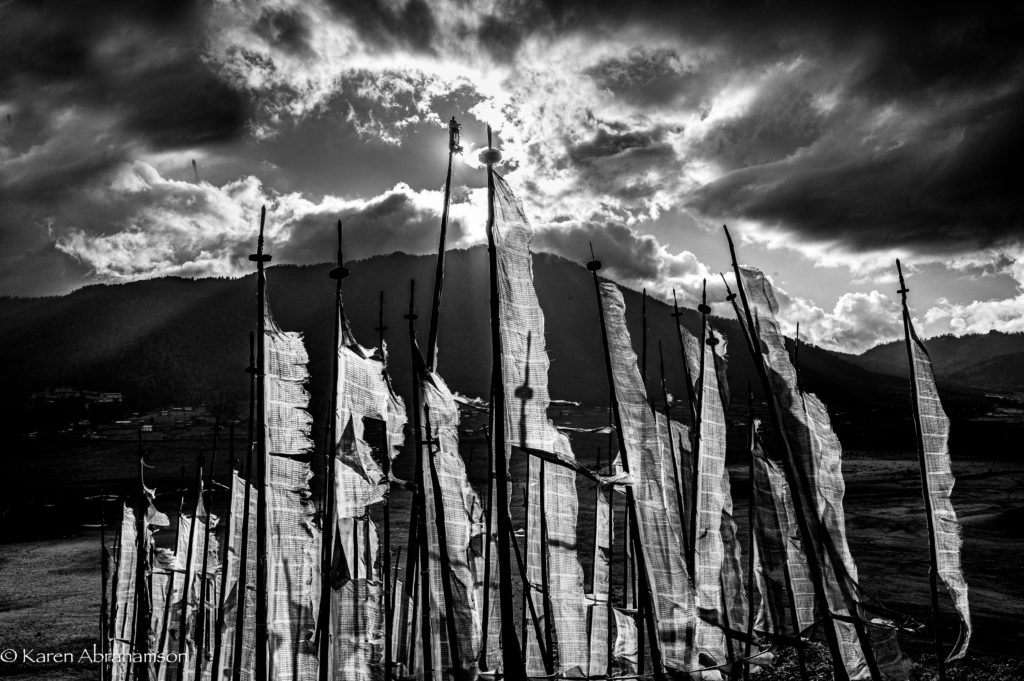
Not long afterward, we were traveling over one of Bhutan’s many high passes where the wind rarely ceases. The peaks of the pass were a mass of poles bearing crowds of fluttering flags and I knew immediately that this was where I had to hang my flags. Wonderful Tenzin helped me sort through them and then our entire group climbed the hill with me and helped hang my flags.
Whether it was for my benefit or whether it was because we all received the benefit of hanging those flags in the wind, the giving nature of everyone involved (foreign photographers and Bhutanese hosts alike) left me quite astounded.
So, I stood in amongst all those windswept prayers and cried.
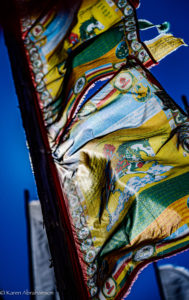
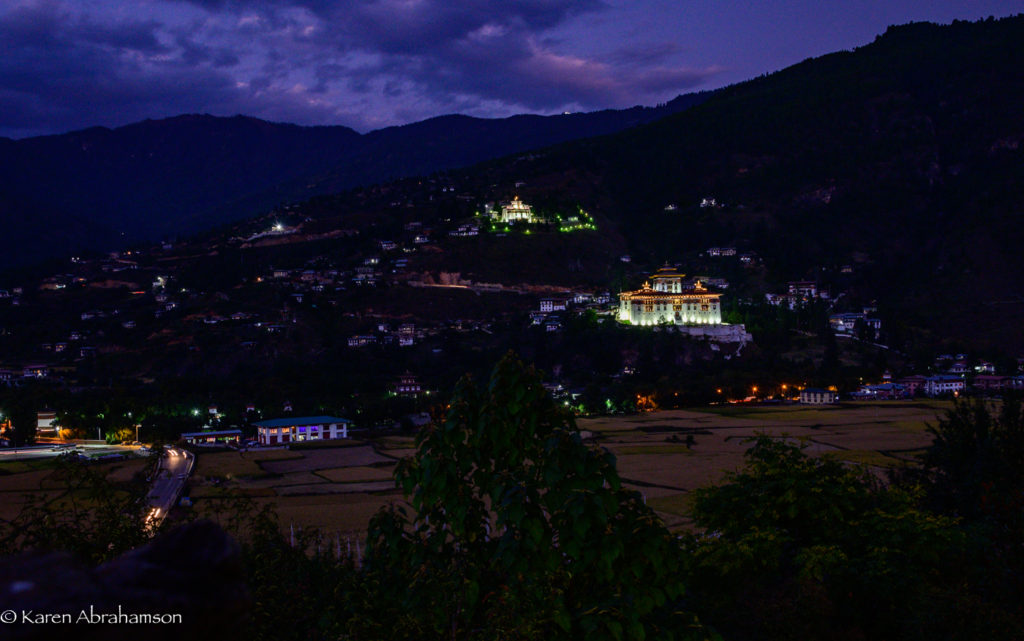
Since returning home and while suffering from jet lag I’ve had a number of people ask me where I was travelling. When I answer “Bhutan” I’ve had a lot of blank stares, so just to clarify, Bhutan is a small Himalayan country pressed, geographically, between Tibetan China and India. In fact, both larger countries have, in the past, taken over parts of Bhutan, with the most recent encroachment being the Chinese moving into and claiming Bhutanese highlands. The Chinese were presumably driven by the need to claim more of the very rare and very valuable Bhutanese cordyceps—a fungus that grows out of a high-altitude caterpillar’s forehead that “purportedly has medicinal powers matched only by rhino horns, elephant tusks and tiger penises” (according to my Lonely Planet guide.)
So, Bhutan whose symbol is the thunder dragon and which enjoys a Tibetan style culture that is purely its own, sits partially in very high mountains and partially in lovely valley floors. The lowest of those valleys is apparently still higher than some of the lowest elevation cities in Peru—the last country that I visited where altitude was involved. Given how altitude sickness struck me in Peru (I couldn’t take the preventative drugs because I was technically allergic to it), I was more than a little paranoid about visiting Bhutan. The skull-shattering headaches I had in Peru made me think I might understand how the caterpillar felt when being attacked by the head fungus. So, in preparation for Bhutan, I decided to go through my own ordeal before I left on the trip. I decided to get tested to see if I really was allergic.
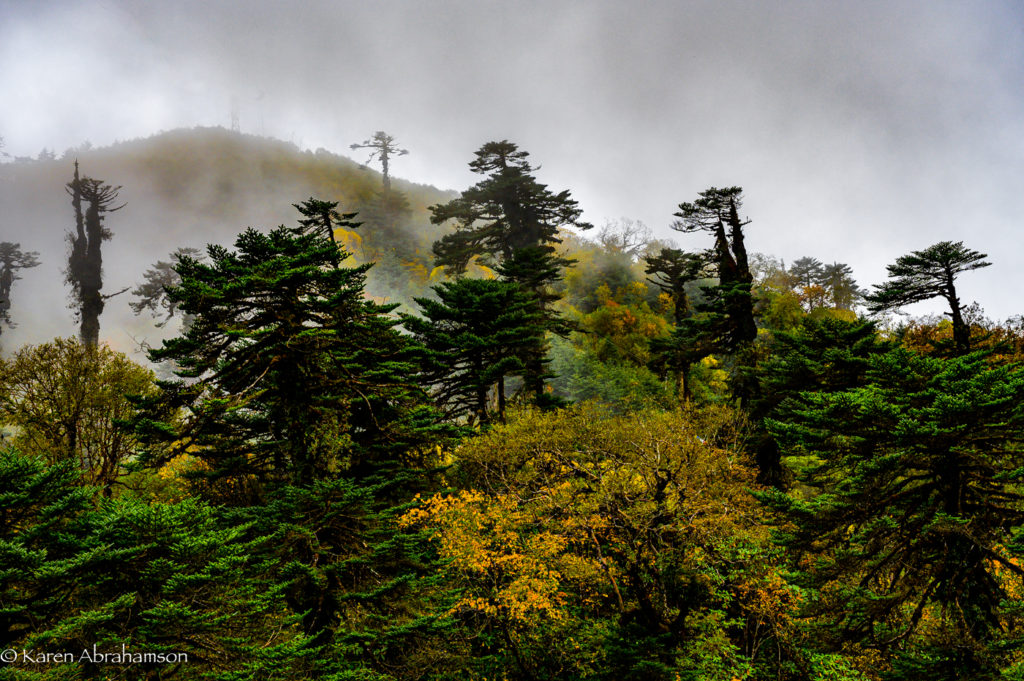
The altitude sickness drug is called Diamox and it is a sulfa-based drug, to which I am allergic (according to doctors that I saw when I was sixteen years old). In the interest of seeing whether my body chemistry had changed, my current family doctor referred me to an allergist—a referral that took three months before I had an appointment, putting me only one month from my Bhutanese departure date. I arrived at the appointment and the allergist took my blood pressure, checked my heart etc., told me that I was healthy (which I knew) and then advised that there were NO tests for sulfa allergies, but if I’d like to go into the hospital for three days they could possibly test me for Penicillin allergies. (I mean what the****?) He suggested that I not take the Diamox but, as an afterthought, suggested that I might want to call the local travel clinic for a second opinion.
Given my experience in Peru and my determination to go to Bhutan, that was exactly what I did. I spoke to the travel doctor who listened to my issue. She told me to take the Diamox—there was, apparently, no cross-reactivity (whatever that means). So I did that, too.

In Bhutan I travelled over passes that were 3,900 meters high and spent days at 3,300 meters—considerably higher than where I became sick in Peru (though at 3,300 meters I had frequent headaches even with the Diamox), but it was worth it. I even climbed a mountain to the Tiger’s Nest monastery at an altitude of about 3,000 meters and am here to tell the tale.
So the perilous Bhutanese landscape was really simply the magical landscape of the thunder dragon, Himalayan mountain peaks, picturesque plateaus and river valley’s so deep they looked bottomless. Everywhere there were towering cypress trees on the heights and rhododendron trees lower down. Rice fields heavy and ready to harvest lay along the valley bottoms and on stepped paddies up the valley sides. Dotting this landscape were the small towns and cities and the huge white-walled monastic fortresses called dzongs.
Most memorable of all were the beams of God-light shining through the clouds to spotlight white-washed temples or green fields. It was—supernatural, superlative, spectacular, breathtaking. And I was able to enjoy it all, thanks to the Diamox.
I pity the poor caterpillar who can’t enjoy the rarified heights where it lives.
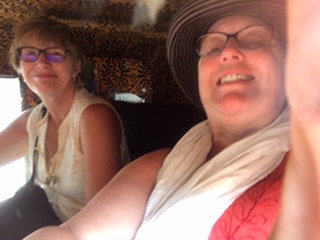 Recently a friend and I took a tour in India. Now first of all, a disclaimer from me: I am not a tour kind of person. I prefer to travel on my own in most situations, however I have done tours in the past that were some of my most memorable travels for all the right reasons.
Recently a friend and I took a tour in India. Now first of all, a disclaimer from me: I am not a tour kind of person. I prefer to travel on my own in most situations, however I have done tours in the past that were some of my most memorable travels for all the right reasons.
The India trip left me and my travel companion thinking that there was more that we should have done to do due diligence before booking the tour. The following list of questions/considerations is intended to help travelers to gather complete information before booking a tour so that you aren’t surprised along the way. These questions are in no particular order.
Consider what you want from your guide.
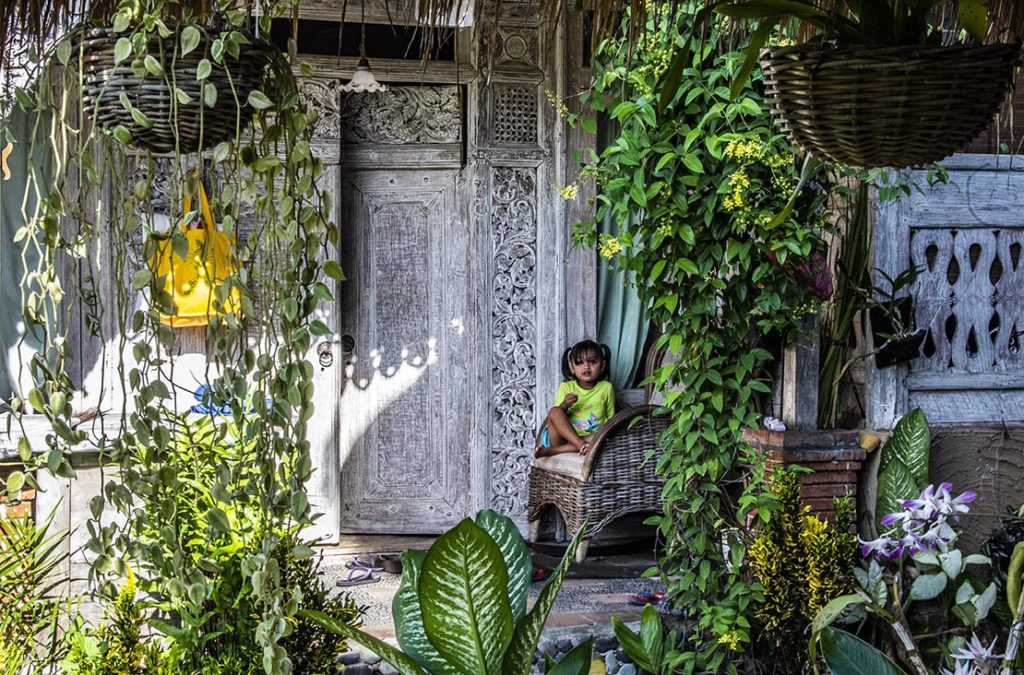
We’ve been in Bali ten days now and it has been a wonderful lesson in exploration—both sensory and experiential. For instance, at the moment I’m in my bed listening to a thundering downpour and the quintessential sound of gamelan music played for a Balinese shadow puppet show.
But not every experience has been quite so mesmerizing. At least they haven’t all been quite so easy to enjoy. Take for instance my first experience at my current guesthouse in the tourist mecca of Ubud. Ubud sits on the lower slopes of Bali’s central mountains and is a mecca for artists from around the world. Think wood and stone carving, silver smithing, weaving, painting and just about anything else you can imagine. We arrived at this guesthouse and our host knew of my interest in photography, so he immediately told me that there was a temple ceremony occurring that afternoon at a local community—come see him at three pm and he’d arrange for me to attend.
I showed up with camera in tow and the only way to get there was via motorcycle—him driving and me on the back. Let me just say that my distrust of motorcycles goes way back to my teenaged years and age and wisdom has only confirmed that opinion.
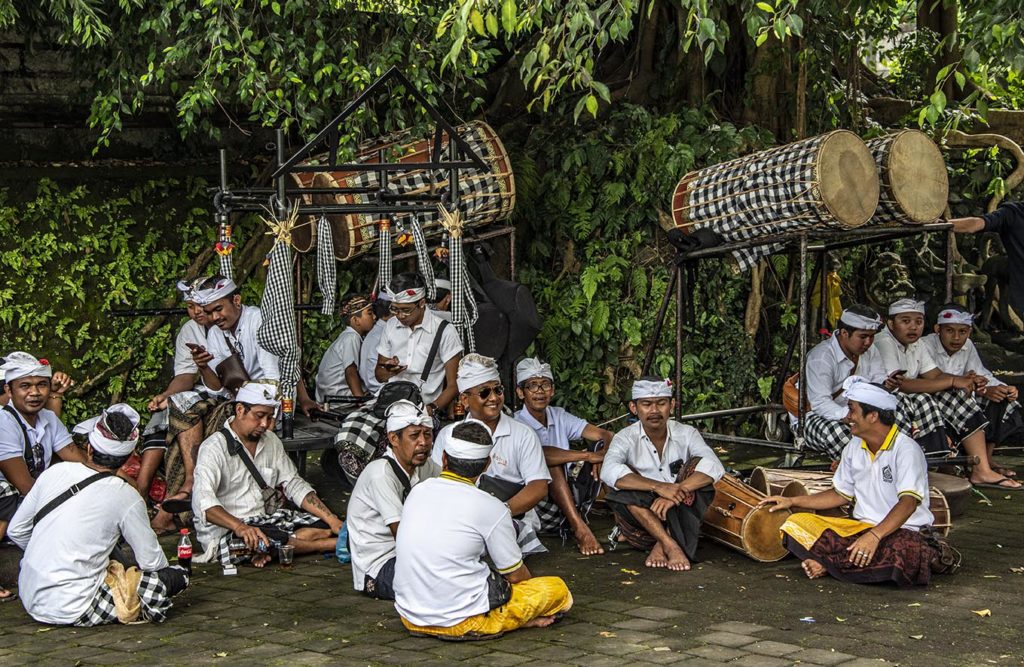
But it was a temple ceremony and I was new to Ubud. Who knew whether I’d get such a chance again. So I slung my leg over the motorbike behind him and drove—sans helmet because he didn’t want to have to carry an extra helmet back—to somewhere in Bali.
And he dropped me off.
Yes, I had his email and phone number on Whatsapp. Yes, I knew the name of the guesthouse and generally where it was in Ubud. But that was all. And oh, yes, I know how to say hello and thank you in Balinese.
But there was this temple ceremony, that it turned out I couldn’t attend because I didn’t have a proper sarong…
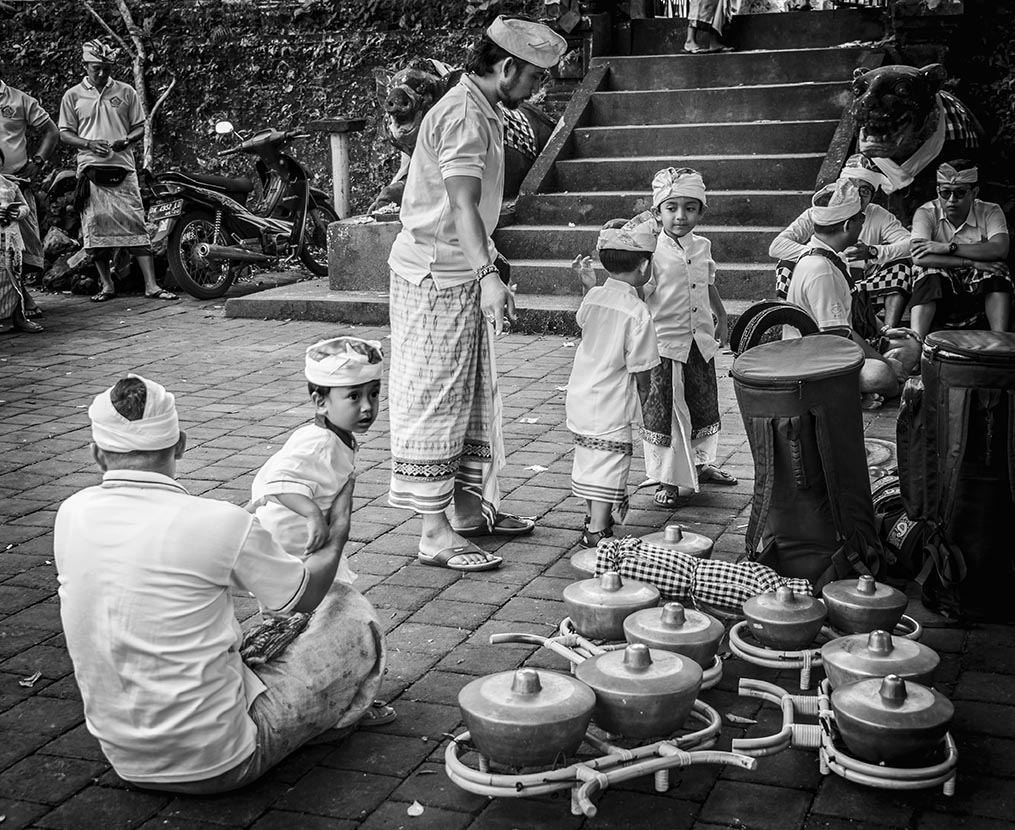
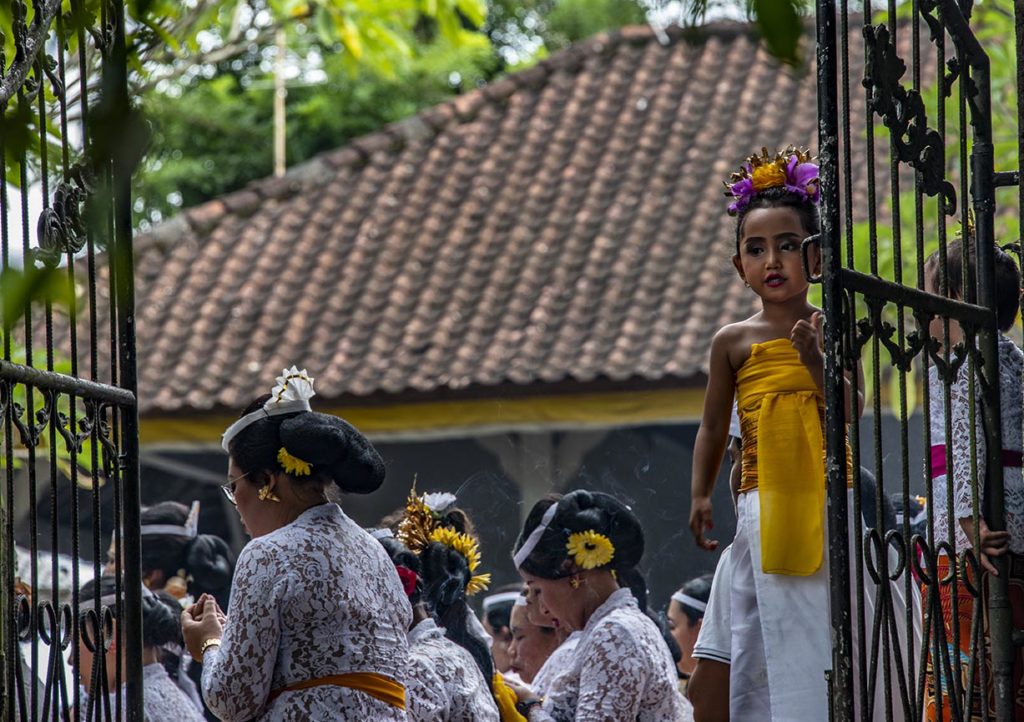
So I hung around outside with the parents with unruly children and the Balinese marching band (think gongs, conches for blowing, and lots and lots of drums.) Luckily, the Balinese are big on processions, because after what sounded from outside the walls like a lovely ceremony, the dignitaries left (would you believe it was the royal family of Ubud?) and were followed by a flood of people.
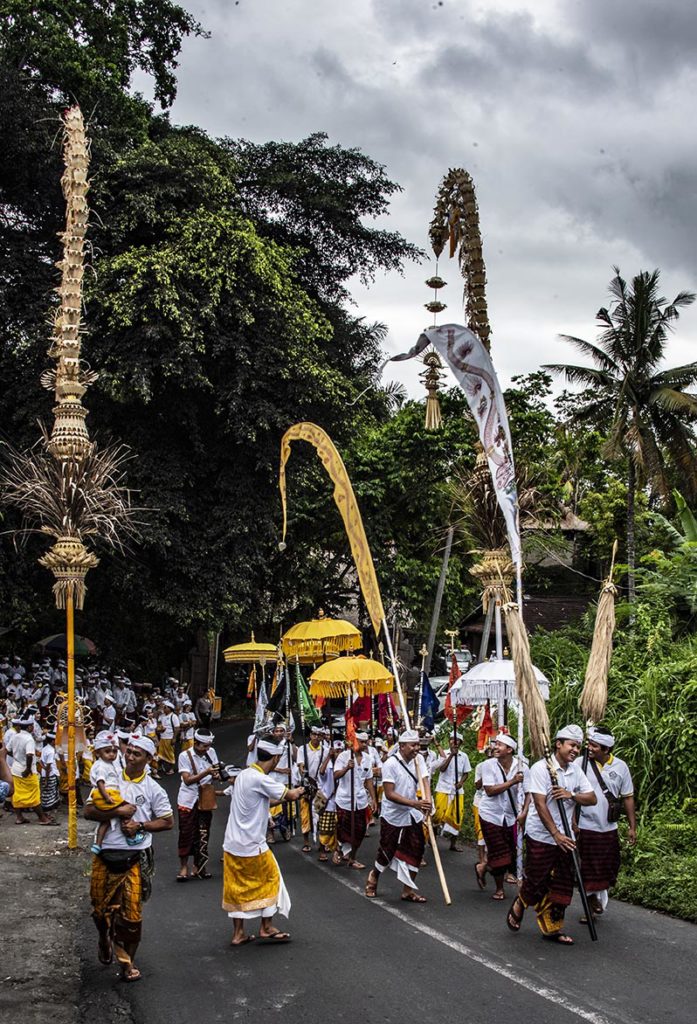
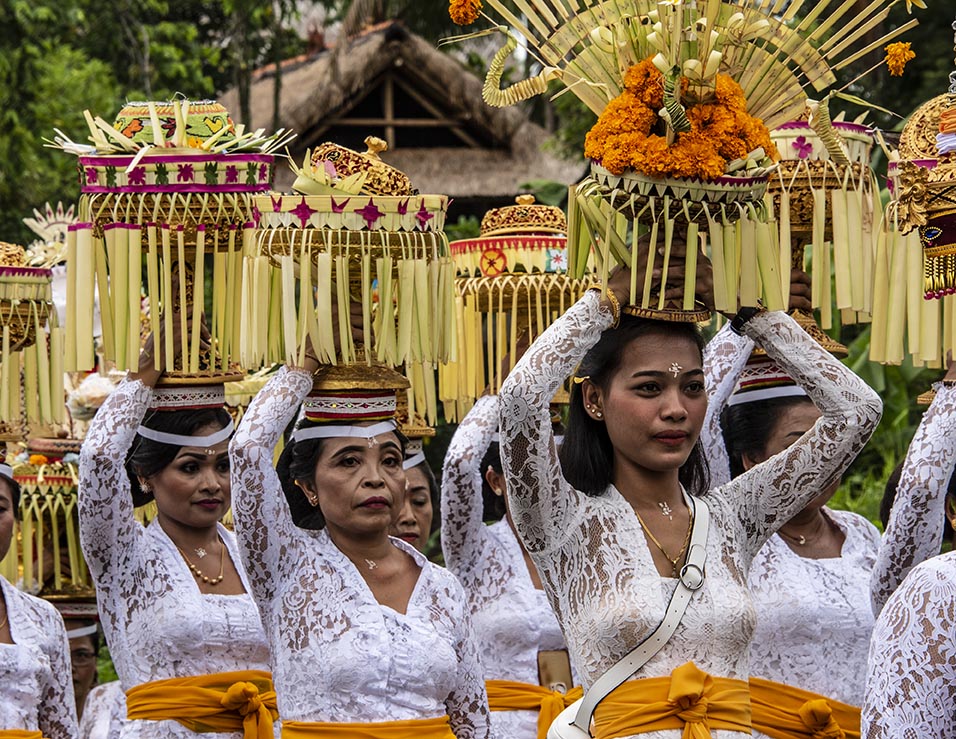
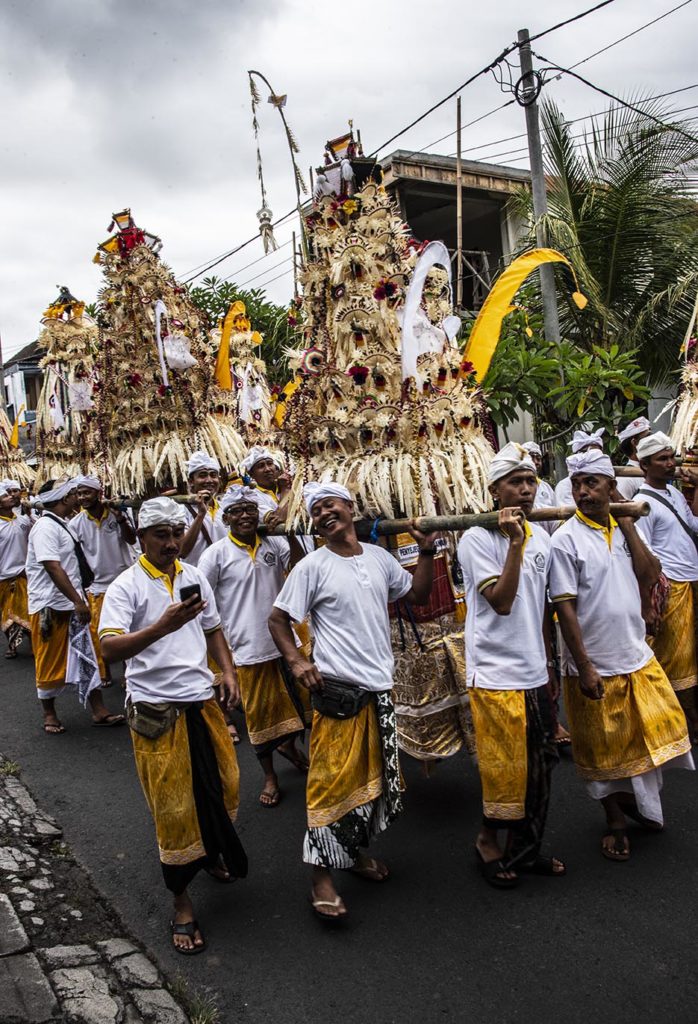
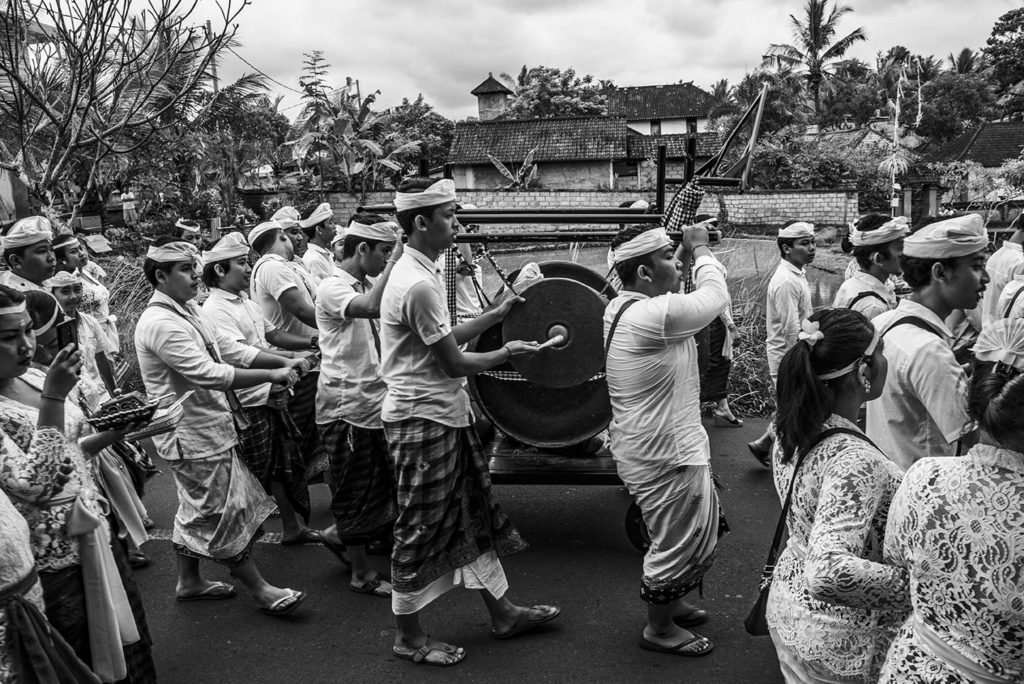
I ran up the road to get a better view and what followed was a village procession. The photos in this post tell the tale. A non-marching band. Children dressed up like princesses. Women carrying offerings on their heads and men carrying even larger offerings on platforms. And all the people in their finest sarongs and sashes. They marched up the road with so much laughter and friendship that I was swept along—until they reached another temple and I was shut out again.
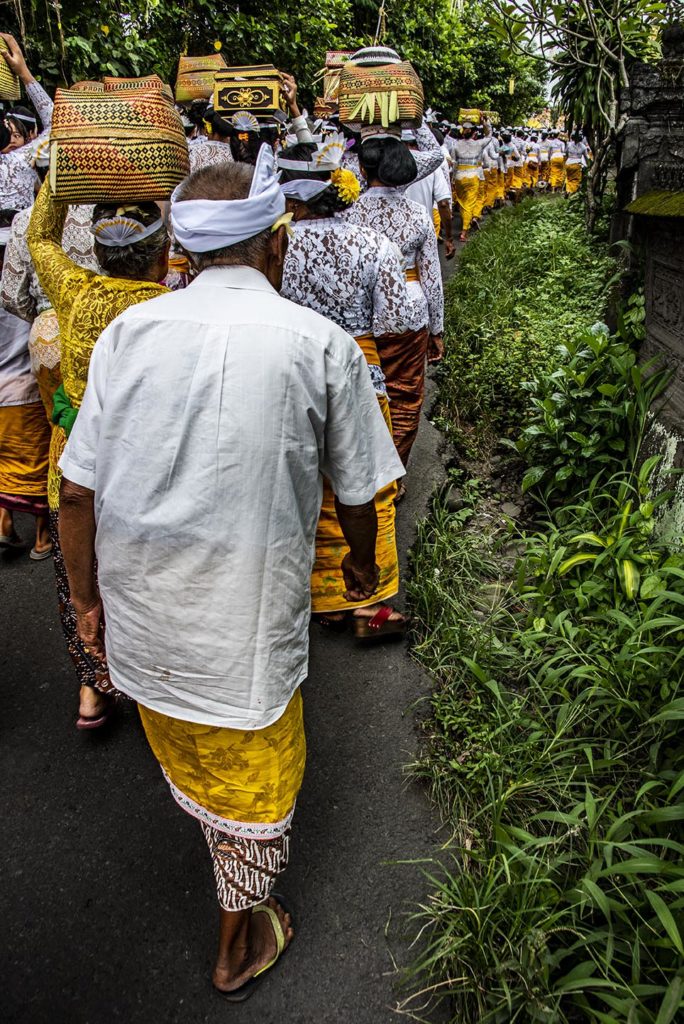
Darned no sarong.
And then I had to figure out how to get home…
From somewhere in Bali.
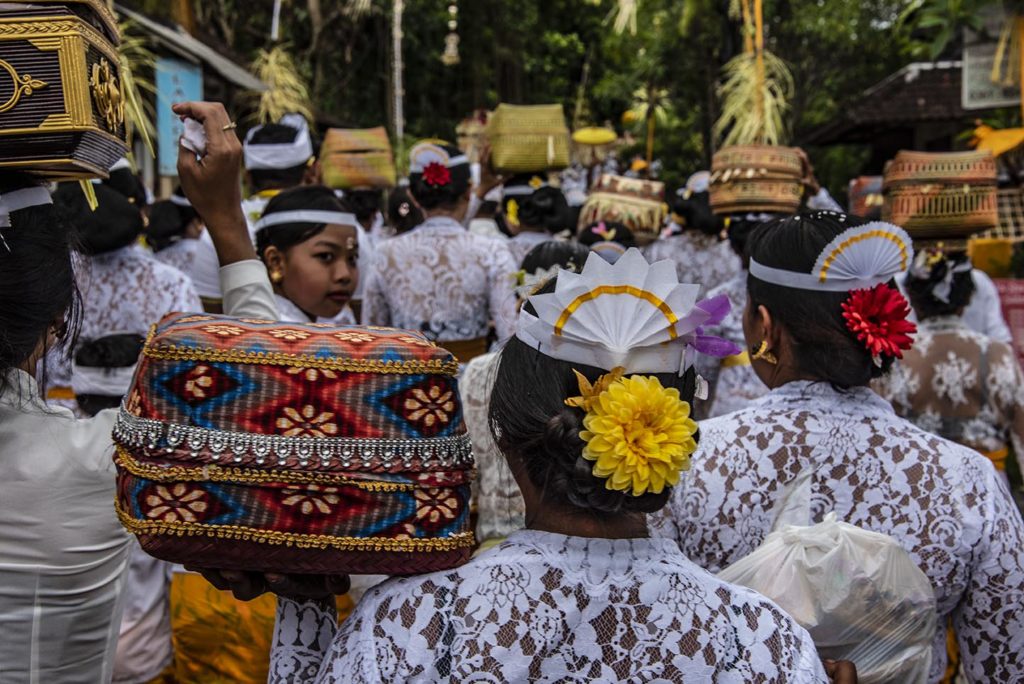
P.S.
(Yes, after realizing that my Whatsapp messages were being routed via North America so there was a time lag, I finally contacted my wonderful host by phone and he sent his son to rescue me. So I am no longer lost.)

We’ve been in Bali since February 4thand the first word I have learned is ‘Salam’, or ‘hello.’ I swear we are both still recovering from our Indian sojourn, which seems odd to me given basically all our travel arrangements were made for us. But then again, when there are issues the stress can wear you down and our trip through India was not without issues. But that’s another story.
For the moment, we are in Bali and trying to sink into the Balinese culture and balance.
We spent the first few days in a place called Jimbaran that is on the coast, south of the major city of Denpasar and the tourist haven of Kuta. We arrived and both of us were overwhelmed by the beauty of our residence. We had a room with sliding glass doors onto a balcony and small plunge pool overlooking the Balinese beach of Jimbaran. It took us a few days to realize that we were right above the Four Seasons resort at less than a quarter of the cost and we were staying in a heritage building owned by an architect who was committed to maintaining the jewel that he had.
A ten-minute walk downhill had us on the sweeping crescent of Jimbaran Beach where I collected shells and, in the evening, we went to a dinner of barbequed, squid, clams, fish, prawns and lobster for about $30.00 each. The seafood, with the addition of rice and water spinach was to die for and as an added bonus we were treated to a spectacular sunset. I’m told that every sunset is just as good.
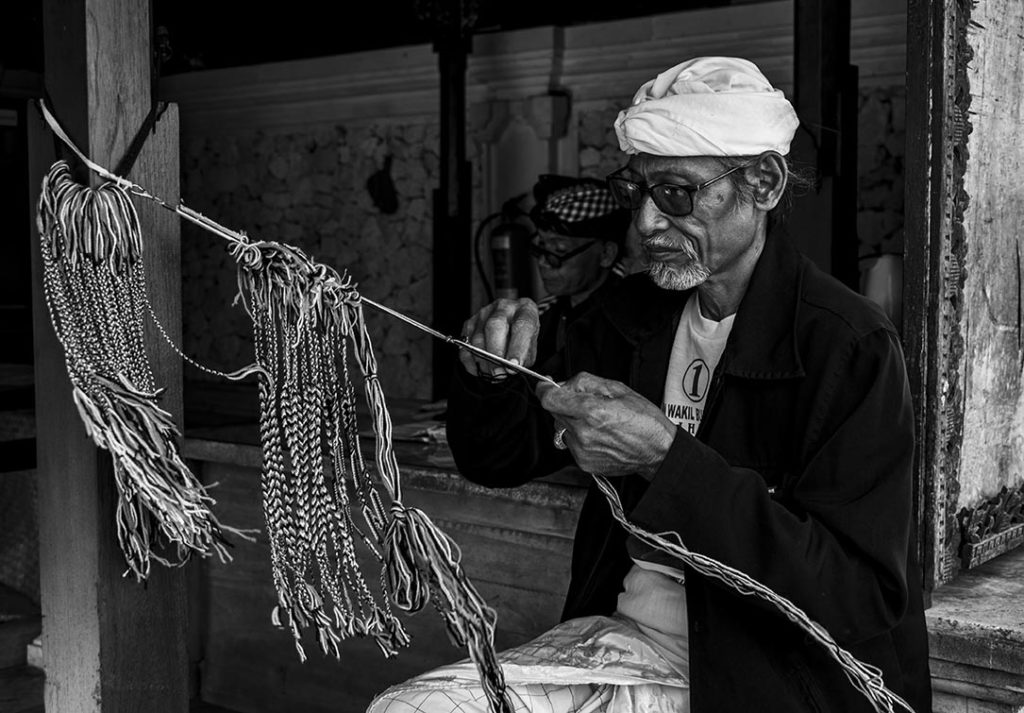
We visited one of the three key ocean temples in Bali, this one called Ulu Watu. We intended to watch the sunset and the sunset Kacek dance. Unfortunately, you can’t actually do both, or at least you can’t watch the sunset over Ulu Watu because the temple is in the wrong direction from where they hold the dance, so the dance won out. While the dancers wear the ornate costumes that you might associate with Bali, the dance itself is actually quite original—at least at Ulu Watu.
The performance begins with about thirty men who come into the performance area chanting, to settle around a tall, wooden candelabra-type stand that has small flames lit on each of its arms. They chant and then, one by one, the dancers entered telling the story of Rama and Sita out of the Ramayana. The difference I saw in this dance compared to the dancers from the performance I wrote about in Kochi, was that these dancers seemed to move in utter, perfected, slow-motion.
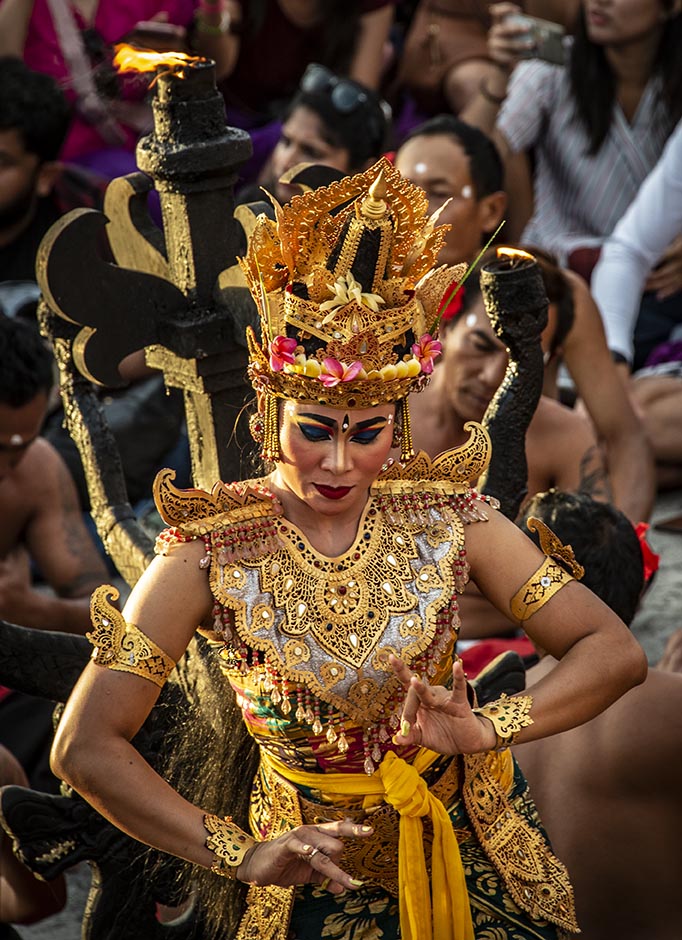
Except for Hanuman.
The mischievous white monkey god was up to his tricks from the moment he entered the story, leaping into the story from on top of the gate, and climbing up among the audience, stealing hats and glasses and picking imaginary nits out of people’s hair.
Anyway, the performance was wonderful, Sita was rescued, the evil Ravana was vanquished, and everyone except Ravana lived happily ever after—except for us, because traffic leaving the temple made us endure a trip home that was well over an hour long.
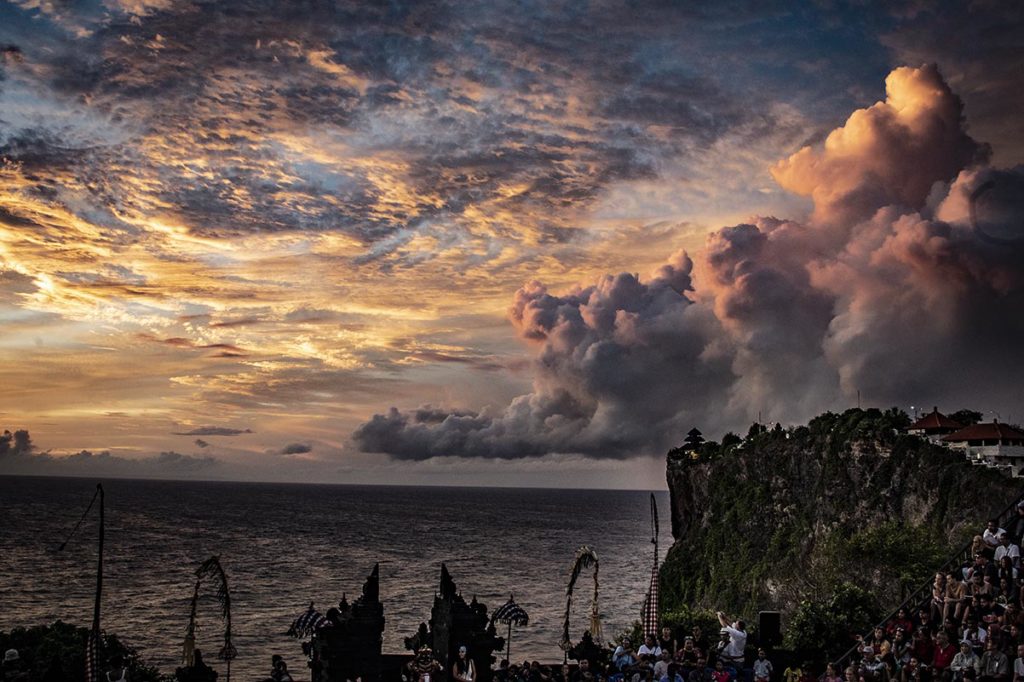
But it was a good introduction to Bali. We’re both impressed, not least of all by the driving. Though there are a lot of cars and motorbikes on the road it’s not the bone-jarring, psyche-scarring, free-for-all we survived in India. Instead, here traffic more or less obeys the traffic lanes and vehicles will actually stop for a pedestrian.
That brings me to the second Balinese word/phase I’m trying to remember: terima kasih, or thank you! Terima kasih for these past few days, Bali.
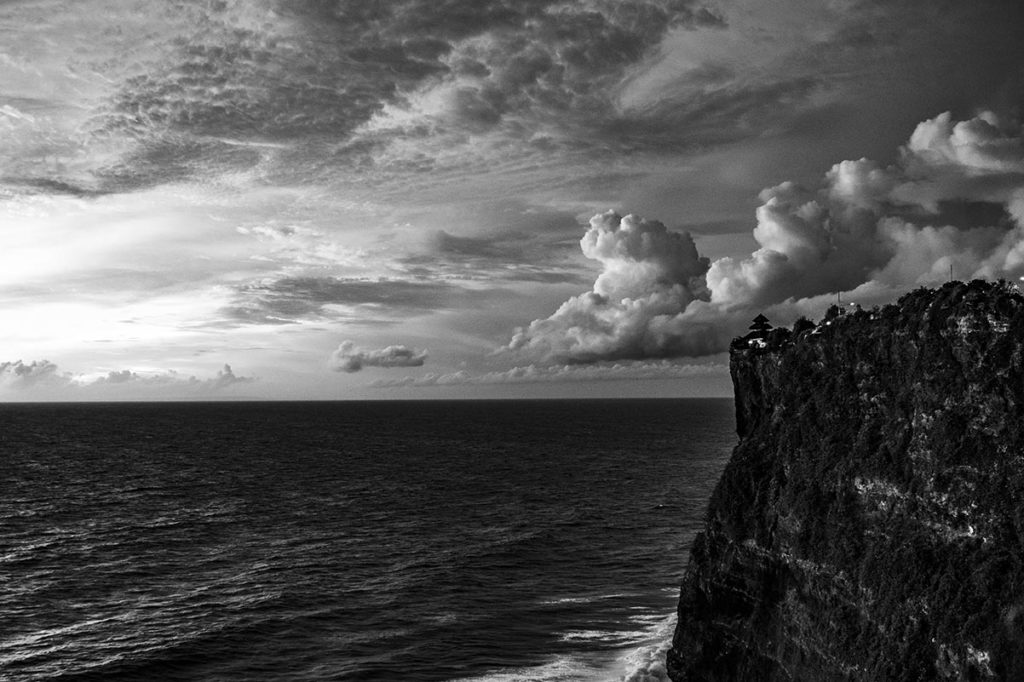
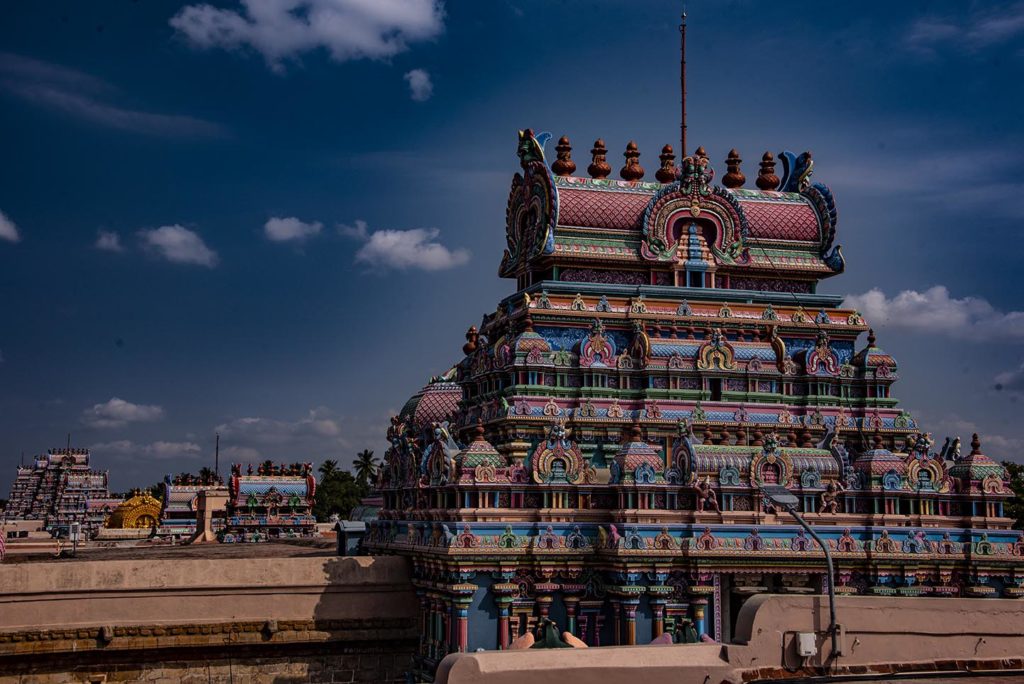
We spent our last week in India on the move. From Kanya Kumari we headed north again, toward our arrival spot of Chennai and Mamalapurum. We broke up our train trip halfway through at a city named Trichy to visit the Sri Rangnam temple, one of the largest temples in southern India—and probably the country. Sri Rangnam is 156 acres and has seven concentric enclosures and 21 magnificent towers (gopuram.) The temple is a world heritage site that has been restored. According to the signs, they had to dig it out from underneath modern structures and have the modern structures removed.
Trichy—at least the part where we stayed and the parts around the temple, seemed like a working man’s city. There were hotels and there were tourist groups, but mostly it was low structures and local bazaars and markets and the people who lived and worked there. A surprise I had in Trichy was the number of Moslem women who had taken the veil. Full burka’s were far more common than the other places we had visited in Southern India which could indicate a higher Moslem population or a more conservative one.
Of course, the sense of Trichy being a working man’s city could be a result of taking local buses around the city instead of rented cars. The busses were an experience in and of themselves. Think of J.K. Rowling’s ‘night bus’ in the Harry Potter series that changes shape to fit between other busses as it careens around the city. The Trichy buses can careen just the same way. Inside, the women sit on the right side of the bus, the men on the left. When no seats are left, people just cram inside.
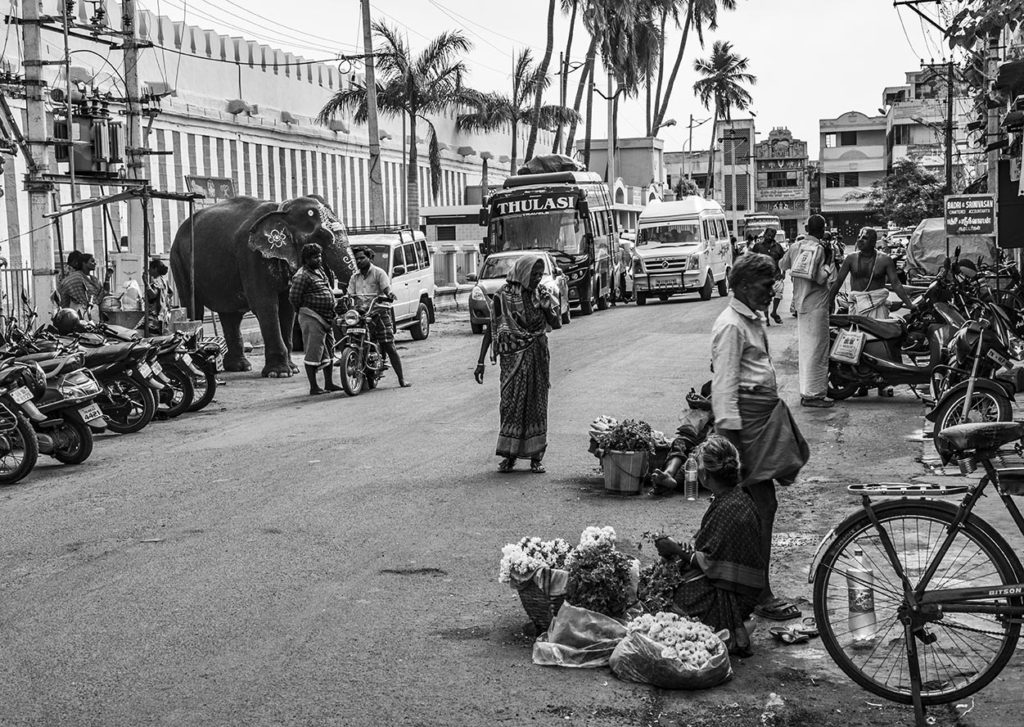
The Sri Rangnam temple is as massive as a small city. It has six concentric walls, the outer wall hosting houses and businesses. Near the main gopuram (gateway tower) the businesses are focused on visitors to the temple with flower-sellers and other religious paraphernalia, but leave the main entrance street behind and you come to almost deserted streets where goats and cows make themselves comfortable and houses stand quiet waiting for residents to return home.
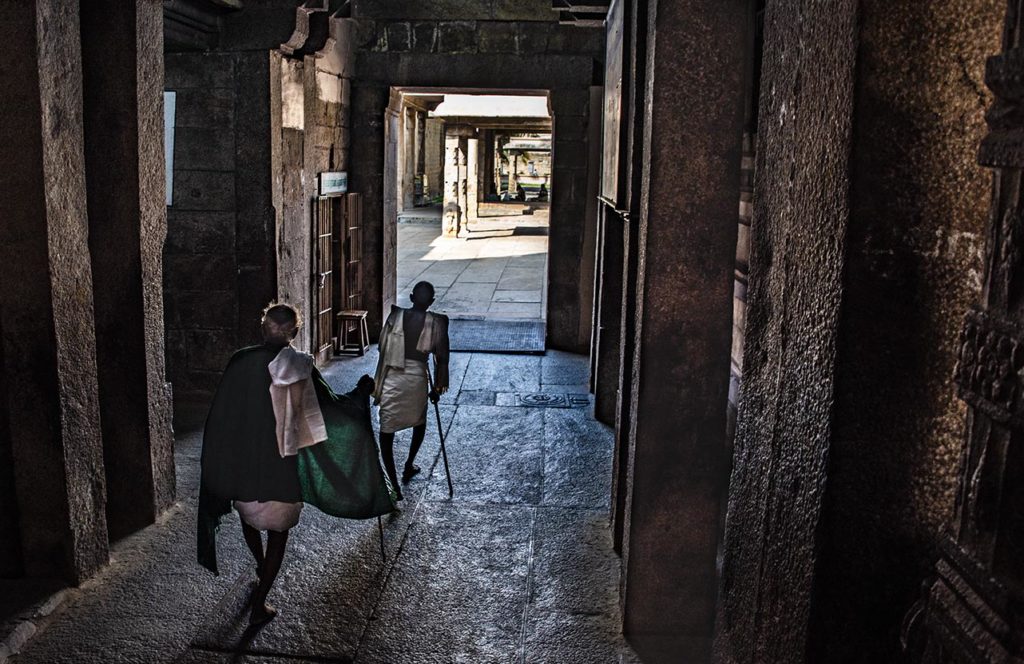
The gopuram are painted in many colors, but the temples beneath them aren’t. Instead, within the fourth gopuram there are ornately carved columned galleries that give relief from the sun. Everywhere are men and women who have made puja today, the men mostly clad in white dhoti (white sarongs folded up around their legs) with white streaks across their foreheads, the women in sari’s with red and yellow tikka between their eyes. There are families with children and beggars sleeping or selling flowers amongst the columns, but from the rooftops you can see across the gopuram to the rest of the city.
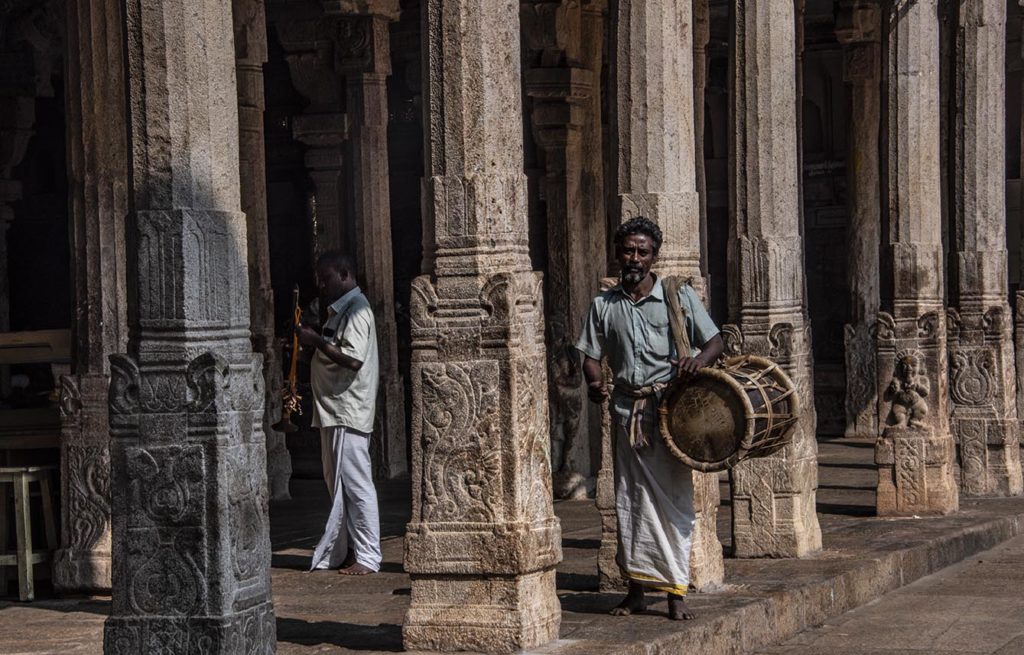
From Trichy, we caught another train and spent eight hours jouncing and bouncing our way back to Chennai, so I left the train with a backache. We abandoned our guide at the train station and headed out on our own to a hotel of our choice in a place called Poe’s Garden. I’m not sure where the area gets its name, but surely it can’t be related to Edgar Allan. The place is filled with pleasant houses and—gardens. Not a single pit or pendulum in sight. The traffic noise barely reaches the place where we’re staying and from our current roof top garden we can only see tree tops and water lilies and the pigeons that come to drink at the lily pool.
It’s a good thing, too. I’m tired. So is my travelling companion and this a pleasant place to slowly withdraw from the frenetic pace we’ve been living on this twenty-nine-day tour of southern India. Twenty years ago, I travelled in India for three months and fell in love with the country. After this trip, I’m far more ambivalent. I’m not sure why. Maybe it’s just the fatigue talking, or maybe it’s the fact that this was a tour that didn’t allow the freedom to travel the way I like to. As it was, I felt like I was watching a movie through a blindfold that would be stripped away for moments so that I could catch a glimpse of something marvellous, but never fully comprehend what I was seeing.
But then, perhaps that’s India. I don’t think it is possible to fully comprehend all its nuances.
Tonight, we catch a flight to Kuala Lumpur and on to Bali. Our first guesthouse is also supposed to be in a garden, this one with views of the ocean.
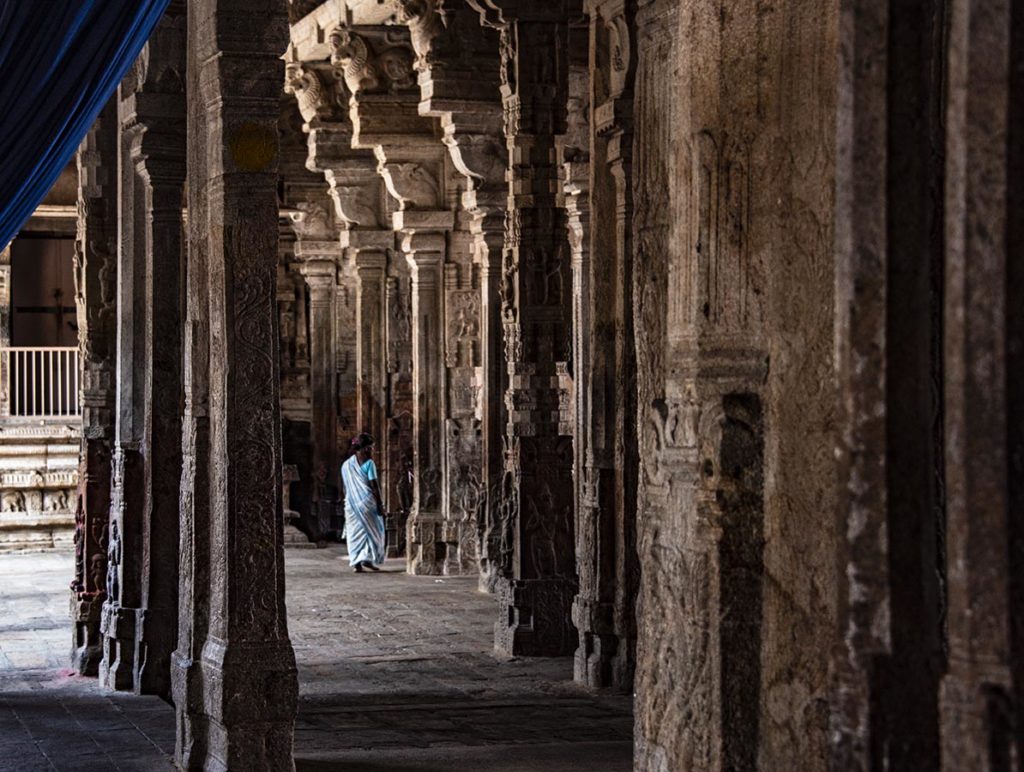
We’ve been in Goa for three days and I am really not sure what to tell you other than my impressions of the place have all changed. First of all, I have to admit a certain ignorance of Goa. I knew it had been a Portuguese holding (until 1961) and I knew it had a lot of history in the spice trade, first trading with the Arabs, and then, after Vasco de Gama circumnavigated Africa, with the Portuguese and Europeans. I had even realized that Goa was a state in Southern India.

What I didn’t realize was that there is no city named Goa. Instead the main commercial area is called Vasco de Gama, and the heart of the state is a small city called Panaji. There is Old Goa, but it is mainly a park of lawns set amongst the trees filled with –count ‘em—four churches/cathedrals. We wandered Old Goa in the heat of the day amongst too many tourists. I ducked out to go down to the river (I’m not a huge cathedral fan) and then wandered past a lovely old archway that had once been the entry to the Sultan’s Palace before the Portuguese arrived. From Old Goa we visited Panaji which, unlike the cathedrals, is a bustling town where people live and frequent a vibrant market for fish caught from the river and the ocean, vegetables and stacks of fruit and kaju (cashew) vendors who also sell almonds, pistachios and dried fruit. Yum. There are plenty of small market stalls selling everything from the ubiquitous plastic shoe or thong, to caskets and undertaker services.
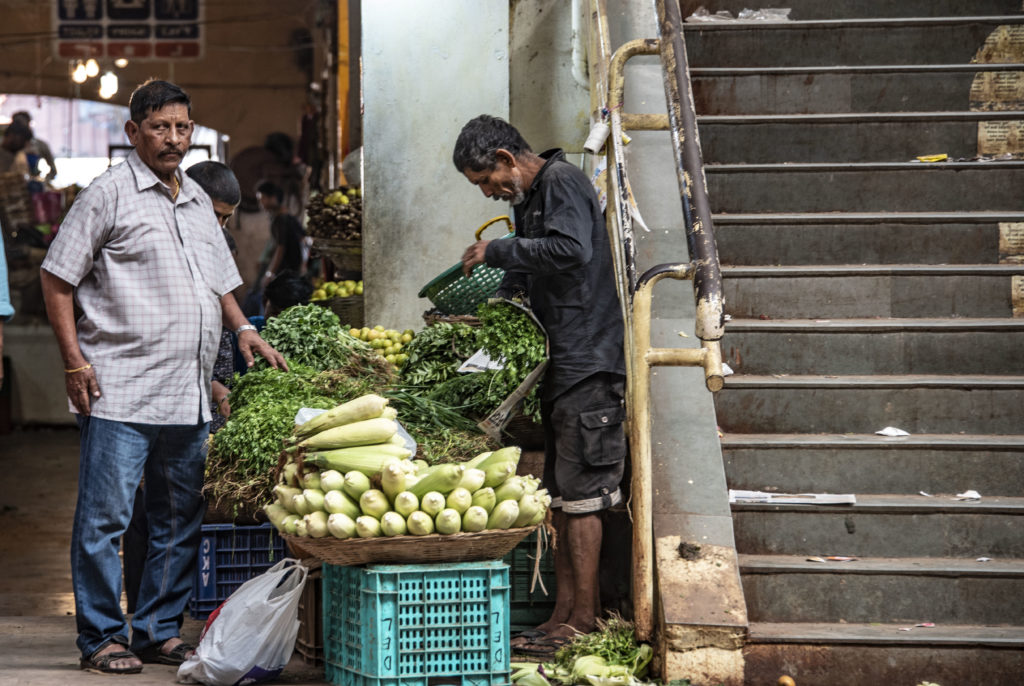
The neighbourhoods are old here and full of cock-eyed streets lined with brightly colored houses. We drove through to a scenic point that wasn’t that scenic and then went back to our hotel. I’d intended to return the next day to photograph the lovely streets, but the next day we decided to avoid the heat and the hour+ drive to Panaji. So instead we arranged to visit a couple of old Goan mansions closer to Colva (the beach town where we were staying.)
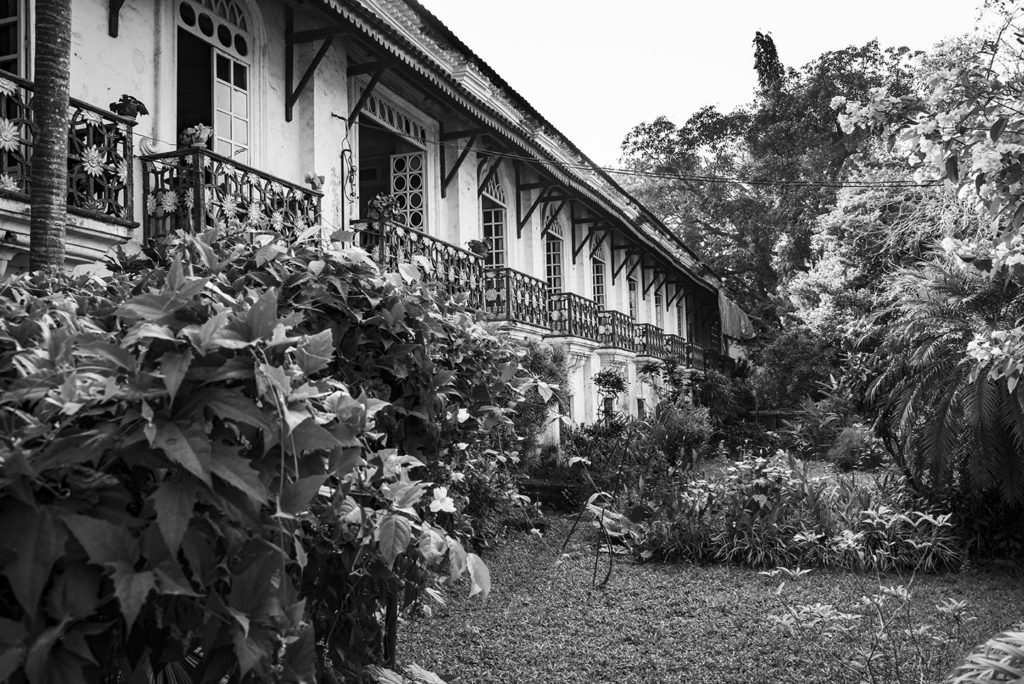
Turns out it was a treat. The Bragancia house has to be Olympic sized figure skating rink in length. It has lovely Juliet balconies lining the front and the place, though showing its approximate 250 years of age, is gently being restored by the owners who are direct descendants of the Bragancias. One of the Bragancia sons toured us around a blue painted ballroom and lovely gallery filled with rosewood furniture, chandeliers, paintings and portraits, and a pair of chairs that were a gift from the Portuguese king. There was even a pair of palanquins used to carry the husband and wife when they left the house. The family was Goan, but were wealthy landowners and were actually gifted with a coat of arms from Portugal.
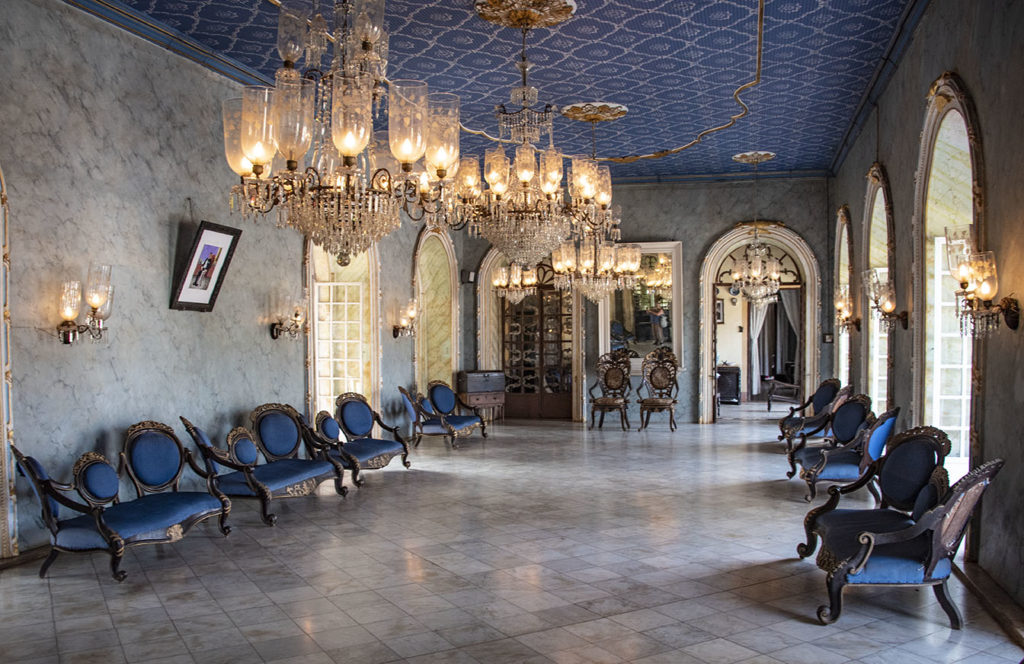
The second home, the Fernandes House was more run down, but far more fun. Again, the home is still owned by the Fernandes family and the youngest son, Ranjeev toured us around. He had an infectious enthusiasm for his home, that had a similar design to Bragancia though it was about half the size in length. The fun side was Ranjeev pointing out old bullet holes in the walls and taking us through a secret passage that led from a ladies dressing room to the basement and out to the river so the family could escape attack. It was lovely and sad and I donated 500 rupees to help the restoration cause.
From there we visited Chandagahr (sic) hill and the temple at the top. The hazy air prevented any views of the ocean or the old mansions at the foot of the hill, but it was cool and breezy and the sun was setting. Back at the foot of the hill the green rice paddies glimmered between the trees in the amber air.
The other thing I learned about Goa is that I can’t figure it out. I didn’t see any thriving commercial centre like in Chennai or Mysuru. Instead, the 115,000 people of Panaji live sleepily amongst the trees. So did the people around the beach town of Colva and in the city around the main train station. I kept wondering whether Goa was sinking into forest dotage, or just growing out of the jungle foliage. I still haven’t figured it out, but last night driving to the train station I settled on syncretisation. The animistic tribes held Goa first and this was ploughed under by Hindu kings who accepted local practices, but placed their own beliefs above the old religions. The Islamic sultans who destroyed the Hindu empires did much the same, practicing tolerance of Hindu worshipers. And then the Portuguese came and Catholicism. So now Goa is largely a Christian place with cathedrals so frequent you could trip over them though Muslims and Hindus still are here. There are convent schools and places of education dedicated to Jesus etc. so I suppose you could say that Christianity is the latest ‘winner’.
But not totally.
Last night as we rode to the train station alongside the road there was Hindu shrine with garlands draped over the god image and a brass bell that was rung and a small fire to bring light into the world. A hundred feet farther back down the road we’d passed a non-descript stone Christian cross draped in similar floral garlands so that it appears that far older cultural practices are being woven into Goan Christianity today.
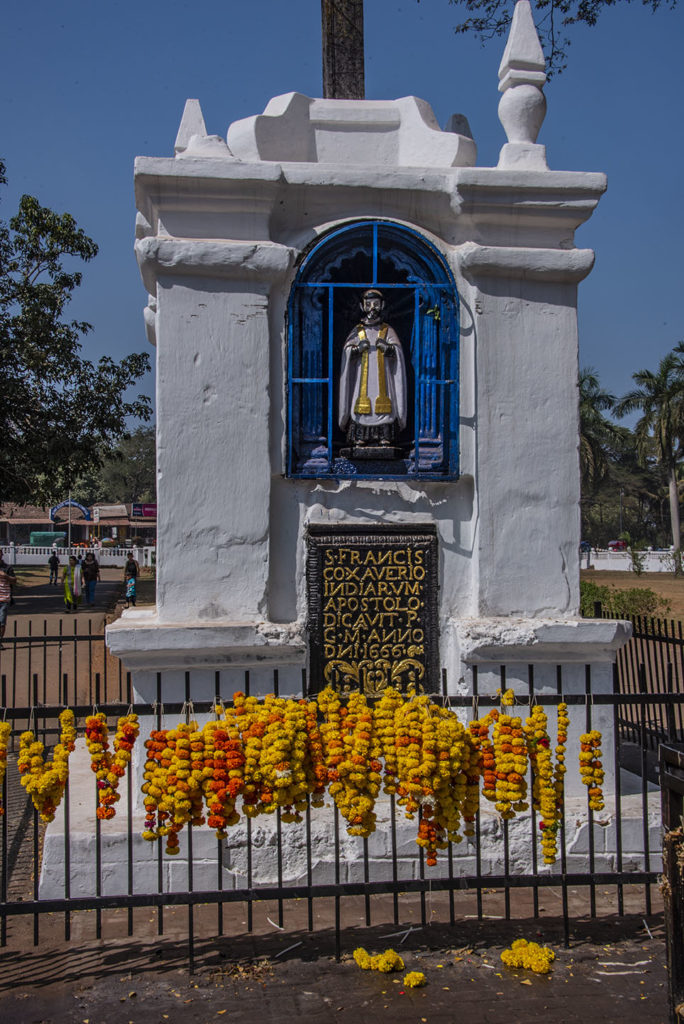
Postscript:
My favorite sign from my time in Goa: All Goan Toddy Tappers Association. It doesn’t refer to tap dancing, but to tapping the toddy palms to get the sweetness of their blossoms. From this comes chaggery sugar and a powerful liquer. That was something else I learned about Goa in my short stay and non-exploration—it’s the most liberal minded place about alcohol of any of the places we’ve visited in India.
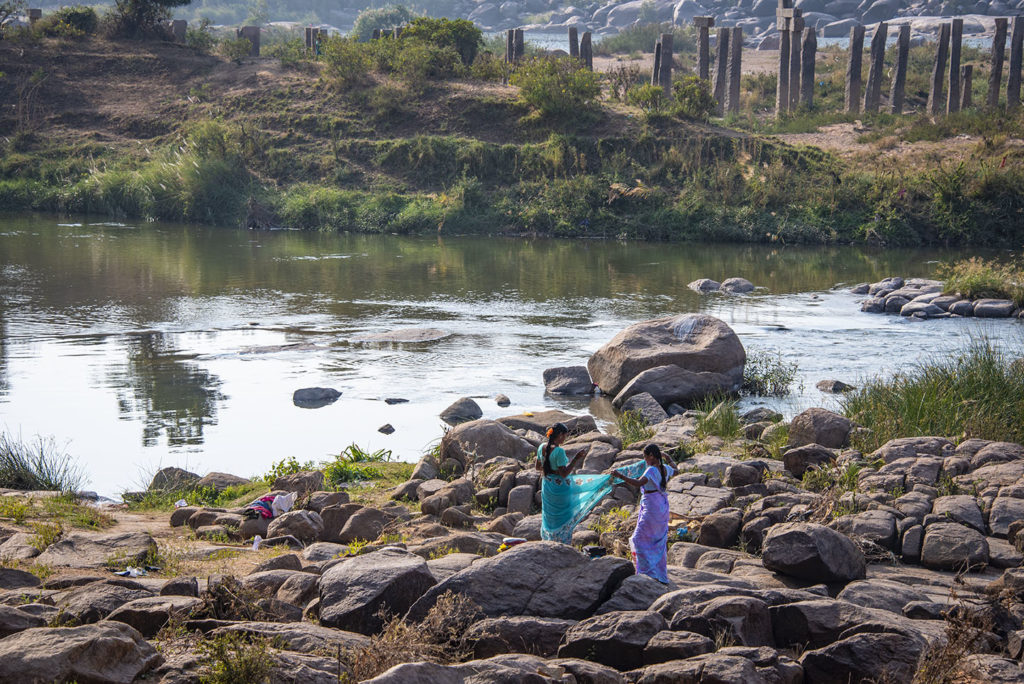
I’m sitting here on the train to Goa from Hampi. The train came from Calcutta and is already three hours late. That’s India. Nothing ever turns out as you expect.
Like the day before yesterday when at the end of the day we visited a hilltop temple that overlooks the Hampi ruins. Hampi is an ancient capital (early 1300s) that is actually mentioned in the epic Ramayana. By the 1600s it held over 500,000 people, but then it was sacked by a confederacy of rival sultanates. The ruins of the city remain today and are spread over 36 square kilometers around other-worldly mounds of boulders that seriously look as if they’re the remains of another, far older, civilization.
To see the sunset we went up beyond the temple’s rear gate where the light was turning pale gold and illuminating the heaps of boulders. We stayed there awhile with a family having a picnic. The light wind filled my face and the ubiquitous Indian haze softened the distance. Standing there, I felt like I could inhale the softness, especially after the music started playing in the temple. We headed back down to the temple and sat down to enjoy the peace. Then an orange-clad priest invited me up into the temple to take a seat and take part of the music. I don’t know quite what I was playing—small metal cups that you clap together in a syncopated rhythm. I was very bad at it, but I was still offered puja and a blessing. An unexpected welcome to Hampi.
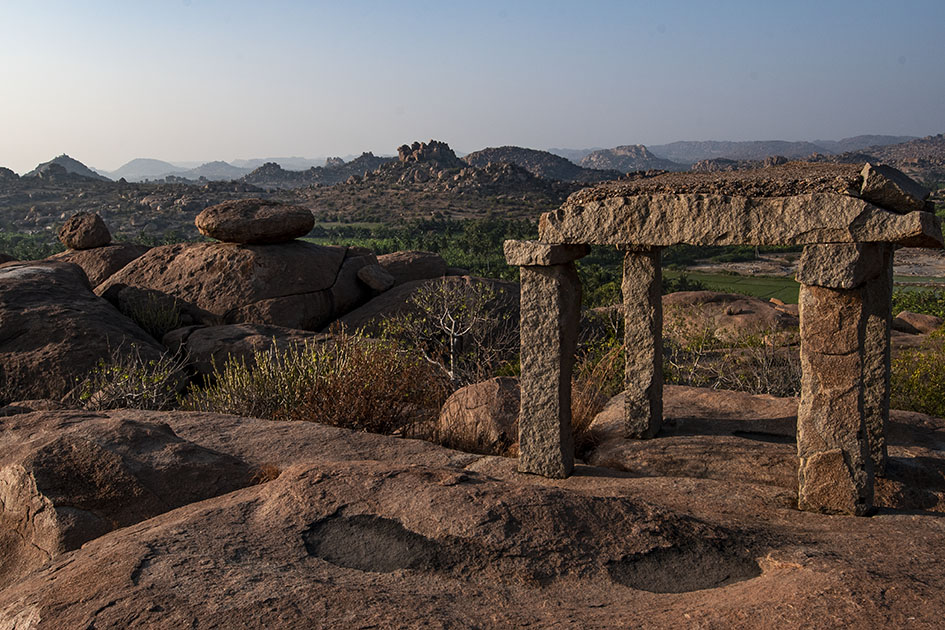
On the other hand, yesterday I wanted to take photos of the sunrise over the Hampi ruins. Maybe it was my need to book end the visit—sunrise and sunset—so I was up at 5 am and had a driver arranged to take me to the ruins. We drove to Hampi and he dropped me at the stairs/trail that led up a very tall hill to the optimistically named ‘Sunrise Point’. The stairs were made of huge, uneven, pale slabs of stone that I could barely see through the darkness of pre-dawn. By the time I made it to the top of the stairs I was panting. Then I was faced by a conundrum—carry on, on a wide dusty path, or follow a sign that pointed off the main trail to Sunrise Point. Being Canadian, I followed the sign and found myself on a spider web of trails that led up and over boulders and through the brush. I found another set of stairs leading upward and headed up. And up. Over bounders. Up rough stairs. And up some more until I found a young French girl perched alone on a boulder like a messenger in a Dungeons and Dragons game. Above her was an even bigger boulder with vague indentations chipped into them as stairs.
She said she’d stopped where she was because she was afraid to go further, but more afraid of trying to get down. Looking at those half-formed stairs I totally got what she was saying and decided to stay there to photograph, if not the sunrise, at least the landscape as the sun turned it gold.
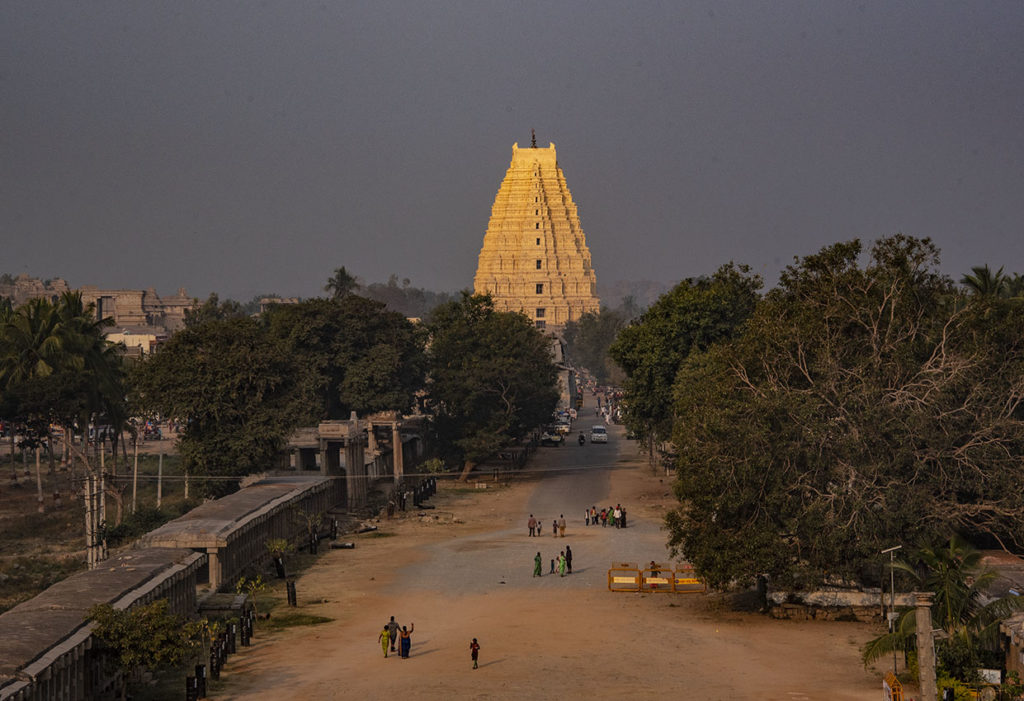
When the light changed, it seems that her assessment was correct. I headed down the rough stairs until I reached the place where I’d left the brush. Then I struck out on the path back towards my original stairs.
Only to have the path run out.
I retraced my footsteps and took another fork. It ended, too, and so did others so that eventually I had to make a decision: Go back to the second set of stairs if I could find them again (given the first set had mysteriously disappeared,) or get to the base of the mountain and hopefully find a path. I chose the latter and after much battling with cactus and thorn trees, bloodied, sweating and actually wondering what I would do if I fell and broke something, I found the bottom and a well-worn path next to a field of banana trees. That path eventually led me back into ruins where I enquired of a Japanese tour group what direction I should be going. I did find my way back, but I bear the thorn and cactus scars of my adventure.
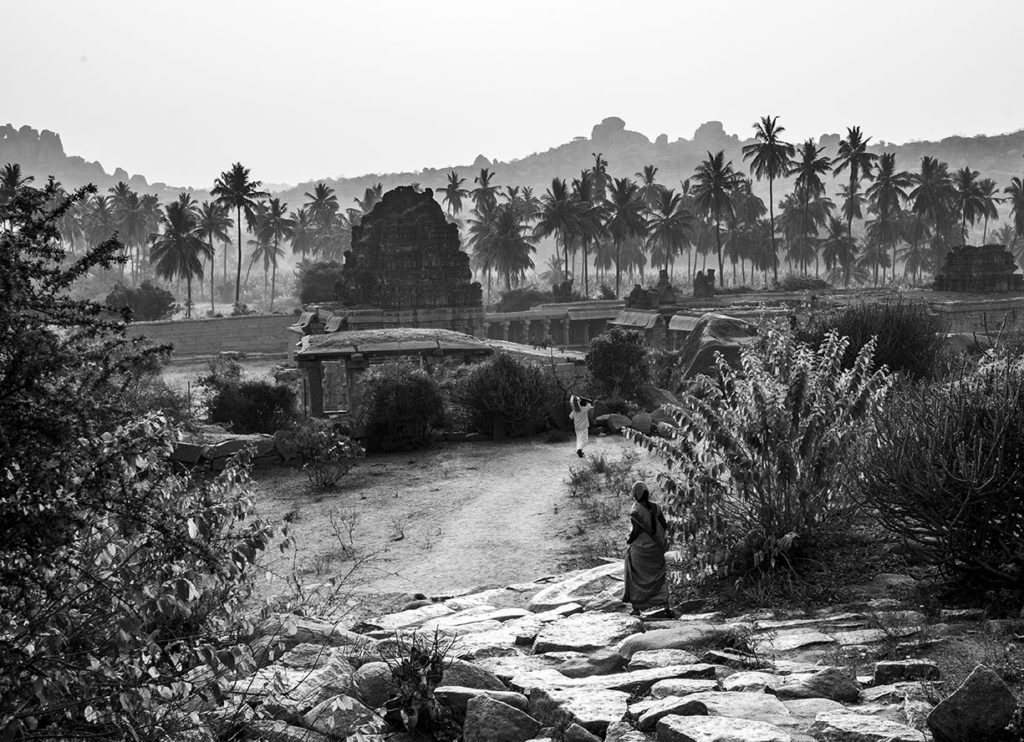
So the lesson I’ve learned (actually, I should have remembered from my previous visit to this country) is that (for good or bad) in India nothing ever happens the way you expect.
Oh yes, and the train—we lost another three hours on our journey to Goa, arriving six hours late. I guess I should have expected it.
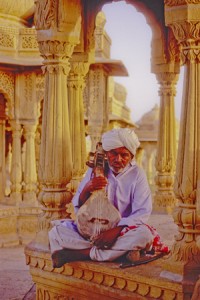 Starting in January, I’ll be off on a research adventure in Southern India, Bali and Hong Kong. You might recall that Phoebe Clay, my character in my mystery novel, Through Dark Water, ended book one with an interest in global travel. This is my chance to scope out interesting locales for her next adventures. I’m planning to get back to Phoebe and co. and their mysteries on my return from Asia.
Starting in January, I’ll be off on a research adventure in Southern India, Bali and Hong Kong. You might recall that Phoebe Clay, my character in my mystery novel, Through Dark Water, ended book one with an interest in global travel. This is my chance to scope out interesting locales for her next adventures. I’m planning to get back to Phoebe and co. and their mysteries on my return from Asia.
During my travels I’ll be posting regular photos and mini stories like those in the travel section of my website so keep an eye open for these on my website and on Facebook.